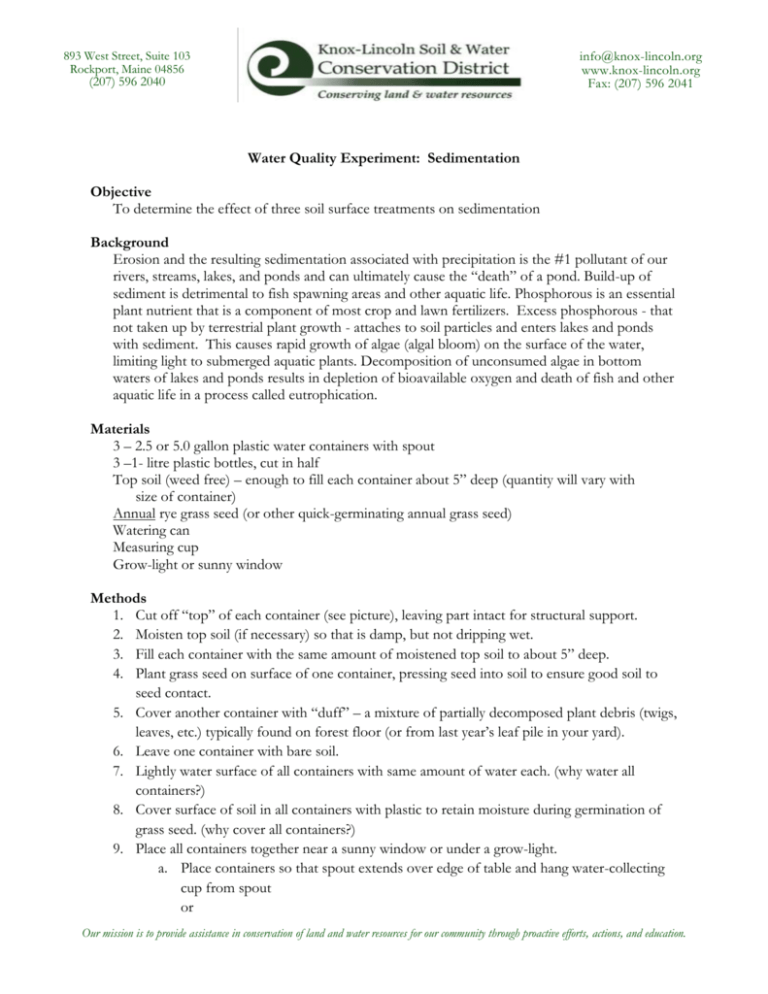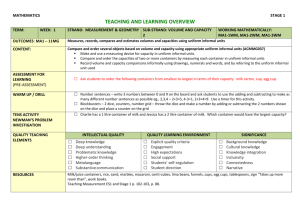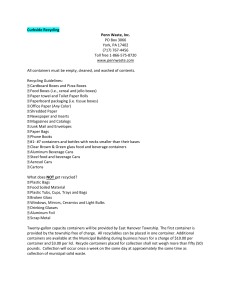Water Quality Experiment
advertisement

info@knox-lincoln.org www.knox-lincoln.org Fax: (207) 596 2041 893 West Street, Suite 103 Rockport, Maine 04856 (207) 596 2040 Water Quality Experiment: Sedimentation Objective To determine the effect of three soil surface treatments on sedimentation Background Erosion and the resulting sedimentation associated with precipitation is the #1 pollutant of our rivers, streams, lakes, and ponds and can ultimately cause the “death” of a pond. Build-up of sediment is detrimental to fish spawning areas and other aquatic life. Phosphorous is an essential plant nutrient that is a component of most crop and lawn fertilizers. Excess phosphorous - that not taken up by terrestrial plant growth - attaches to soil particles and enters lakes and ponds with sediment. This causes rapid growth of algae (algal bloom) on the surface of the water, limiting light to submerged aquatic plants. Decomposition of unconsumed algae in bottom waters of lakes and ponds results in depletion of bioavailable oxygen and death of fish and other aquatic life in a process called eutrophication. Materials 3 – 2.5 or 5.0 gallon plastic water containers with spout 3 –1- litre plastic bottles, cut in half Top soil (weed free) – enough to fill each container about 5” deep (quantity will vary with size of container) Annual rye grass seed (or other quick-germinating annual grass seed) Watering can Measuring cup Grow-light or sunny window Methods 1. Cut off “top” of each container (see picture), leaving part intact for structural support. 2. Moisten top soil (if necessary) so that is damp, but not dripping wet. 3. Fill each container with the same amount of moistened top soil to about 5” deep. 4. Plant grass seed on surface of one container, pressing seed into soil to ensure good soil to seed contact. 5. Cover another container with “duff” – a mixture of partially decomposed plant debris (twigs, leaves, etc.) typically found on forest floor (or from last year’s leaf pile in your yard). 6. Leave one container with bare soil. 7. Lightly water surface of all containers with same amount of water each. (why water all containers?) 8. Cover surface of soil in all containers with plastic to retain moisture during germination of grass seed. (why cover all containers?) 9. Place all containers together near a sunny window or under a grow-light. a. Place containers so that spout extends over edge of table and hang water-collecting cup from spout or Our mission is to provide assistance in conservation of land and water resources for our community through proactive efforts, actions, and education. b. Place containers on a raised surface about 6 or 8” above table and place watercollecting cup under spout. a. b. 10. When grass seed germinates (~ 2 or 3 days), remove plastic from all containers and water as needed (you may not need to water at all if soil in grass container feels moist when you stick your finger in). If you water container with grass, water other 2 containers with the same amount of water. 11. In about 2 weeks, grass should be about 5 inches tall and roots will have filled the soil in the container. 12. Water all containers with 2 cups of water and let water drain from containers through spout into collecting cups. 13. Record amount of sediment in each collecting cup (most → least; photographically; dry wt) Discussion 1. Is the amount of sediment the same or different from each collecting cup? Why? 2. Is the quantity of water the same or different in each collecting cup? Why? 3. How does reducing sedimentation protect water quality? 4. Do lawns need phosphorous and other fertilizers once established? 5. Is grass the best plant to prevent sedimentation and run-off on a lakeshore or streambank (rooting depth, water absorption, throughfall). 6. What other steps can be taken to protect water quality and prevent eutrophication? Conclusions







